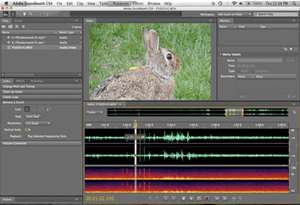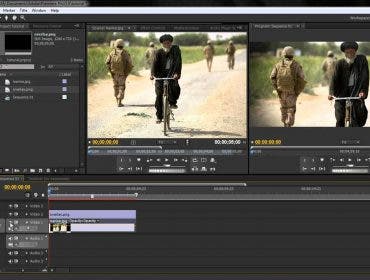
The visual interface of Adobe Soundbooth CS4 is designed for on-track editing. Here I am adding fade-in and fade-out curves to audio captured by my MacBook’s built-in microphone ofthe shutter sound of the Pentax K-7 for possible inclusion as a segment break on our weekly podcast series.
Sure, there’s a few new terms and workflows to understand and grasp, but the interface is designed for photographers, designers, and other folks who aren’t necessarily audio pros. Adobe describes it as “task-based” audio editing, as opposed to the “tool-based” Adobe Audition, another audio editing program in Adobe’s lineup.
Simply put, the Soundbooth task-based model means that you are doing most of your edits and adjustments right on the waveform or spectral frequency display. Honestly, it’s nowhere near as scary as it all sounds, and there are so many cool tools and tasks that will sweeten your audio, clean up stray sounds and more. With Soundbooth you’re seeing sound, and after a little while, it just “clicked” for me. My visual editing skills and understanding of photography, Photoshop, and image information representations such as histograms translated over to working with sound waves and a familiar set of Adobe workflows and tools.
So much of my work on the TechTock podcasts is accomplished visually thanks to Soundbooth. I can now instantly recognize the geometric “ladder” SFD of my phone’s mute beep, and Soundbooth has several ways of eliminating or seriously diminishing this intruding sound, should it overlap important sound. My voice and my guest’s voices have different SFD prints, so it is very easy to quickly identify voice switch points, and boost the signal and shave the noise.

Soundbooth can also be used to edit audio in video clips. The waveform and SFD both show where loud background noises were captured. There are several ways to minimize or eliminate intruding sounds in this program.
Each weekly episode of our podcast is recorded directly into Adobe Soundbooth via a phone tap into my MacBook’s 3.5mm audio in port, and then its a simple matter of boosting the signal, cleaning up the audio to minimize hiss and other undesired noises based on a visual representation of the sound with lassos, marquee tools and other Photoshop-like tools. Then I pull the main interview into a multitrack file (think: Photoshop Layers), pull in the advertisements, roll-in and roll-out tracks and adjust the volumes and export the finished podcast as an MP3 and import into our podcast hosting service and away we go! Before I starting using Soundbooth, there’s no way in the world I’d be able to do this all myself in just about three hours start to finish!
Another very cool thing I’ve been using Adobe Soundbooth CS4 is importing all my old vinyl into iTunes. Every current Mac has an audio-in port that takes either optical or 3.5mm input, as do some PCs. So it’s a simple matter of picking up a turntable with a built-in preamp and recording the audio into Soundbooth (You can skip the USB cable turntable if you’ve got an audio-in option on your computer). If you want, you can leave each side as one long track, or you can split each song off the straight-from-vinyl imported audio file. Then its a simple matter of saving each track with the name of the song and dragging it into iTunes. The only info available will be the track title, but highlight all the tracks off an album and click CMD+i to add album, artist, etc. I’d been wanting to do this for years, but until I learned Soundbooth, the thought of dealing with all that audio editing kept it from happening. Two things I’d like Adobe to consider for future builds of Soundbooth are non-contiguous selections of both waveforms and SFDs, and actions. Either one of these options would make my audio editing workflow even more efficient.
I refrain from calling this a full-on review, as I am not experienced enough in audio editing to truly compare Adobe Soundbooth to other audio editing programs. This is simply me, a photographer, telling fellow photographers that Adobe Soundbooth makes so much more sense to me than any other audio editing programs I’ve seen. If you are struggling or slogging through audio editing for multimedia projects, podcasts, and so on, give Adobe Soundbooth CS4 a shot. Garrick Chow’s tutorials on Soundbooth CS4 over at Adobe TV are a great introduction and an hour spent watching these lessons is well worth it.

